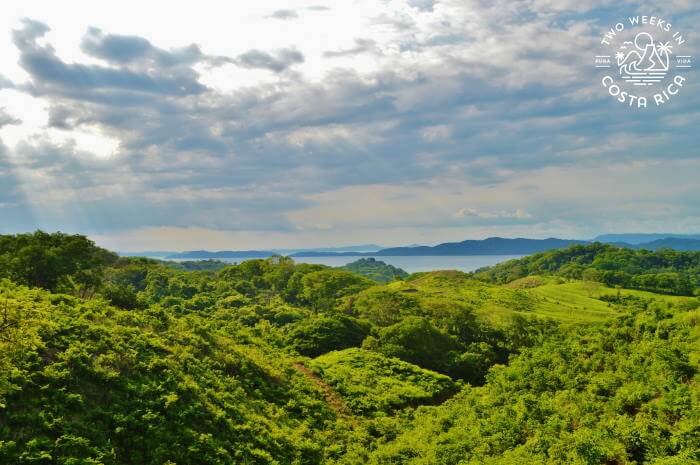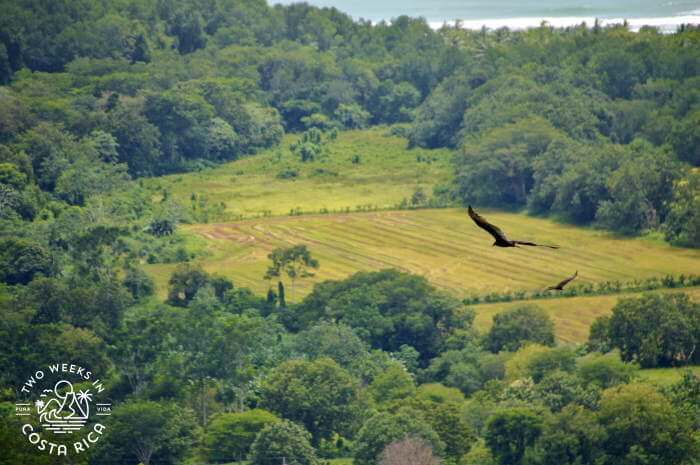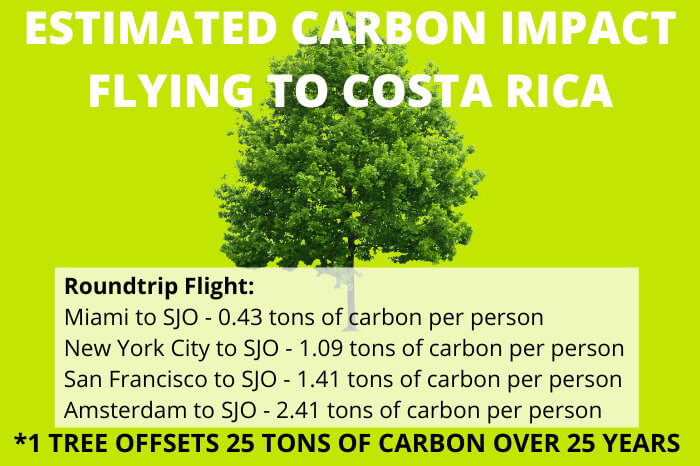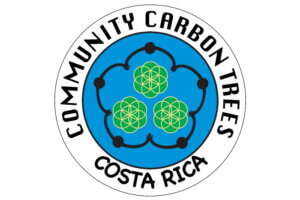If you have experienced a trip to Costa Rica, you already know that feeling. Nature surrounds you and wildlife enamors you, not to mention the exotic plants and flowers, scenic waterfalls, and pristine beaches. Costa Rica feels alive! It’s a feeling that you don’t want to let go of and one that we certainly don’t want to ever lose. Today we are announcing one way that our company, Two Weeks in Costa Rica, is giving back through an initiative with Community Carbon Trees. We’ll also share how you can take part.

Our Initiative
It has always been our goal to give back to the place we love and now call home. With two little boys born and being raised here, we find it even more important.
We both have environmental backgrounds. Matt has a degree in environmental science and studied biology in college. Jenn studied environmental law and still is a lawyer in the United States. Though our paths have changed since our move to Costa Rica in 2013, we still try to do our part for the environment.
With a growing website and travel agency, we feel lucky that we can do something to help keep Costa Rica green, thriving, and a special place for generations to come.
Today, we’re happy to announce a small partnership with Community Carbon Trees. We feel this organization is making a positive impact on the environment by planting trees and offsetting carbon. They do so while educating and enabling the local community to grow and maintain the trees. The model of Community Carbon Trees is unique and has proven to be very effective. You can read more about them below.

Doing Our Part
To kick off our campaign, Two Weeks in Costa Rica is making an initial donation of $2,500 to Community Carbon Trees. This amount will help the organization plant and maintain an ecological corridor with about 100 trees. It also will help nurture relationships with local farmers and community groups.
How You Can Help
We hope our initial donation will make a small impact but are sure that our readers and clients can multiply the efforts.
Each $25 donation plants and cares for one tree until it is mature enough to grow on its own. That means planting, plus paying locals to perform 4-6 years of maintenance. Each tree will offset an impressive one ton of carbon over 25 years.
Here are three ways you can contribute.
1) Plant Trees with Your Shuttle Order – If you book shuttle transfers through our website, you will see the option to add a donation to your order. 100% of those donations will be passed on to Community Carbon Trees (Two Weeks in Costa Rica, Inc. will cover the credit card commissions that are charged).
2) Add Trees When Booking Tours – If you are using our Tour Booking Service, please notify us if you would like to make a donation to Community Carbon Trees. We will add it as a line item on your invoice. Again, 100% of those donations will be passed on to Community Carbon Trees, and we will cover the PayPal commissions that are charged.
3) Donate Directly to Community Carbon Trees – If you are not using any of our website services or just want to donate directly, you can do so through the Community Carbon Trees website. They even have an option for tax deductible donations. If you make a donation, please let us know in the comments below so we know that our outreach is working!
More About Community Carbon Trees
Overview
Plenty of organizations plants trees these days, thousands or even millions of them. But what happens next? Within the first two years, unfortunately, a high percentage of these tiny saplings are suffocated by weeds, killed by drought, or mowed over by machinery. They are planted but not given a chance.
Community Carbon Trees is different. This non-profit organization enlists local farmers (usually cattle farmers) to plant trees on parts of their vast, grassy properties. A section of land is chosen near an existing patch of jungle or along a stream. This develops wildlife corridors that allow animals to safely move from one area to another. It also creates natural buffer zones between farming and development, and the rainforest.
Using donation money and grants, Community Carbon Trees pays the farmers to plant, fence off, and maintain the saplings. They periodically chop the grasses around them and protect them from harm. If one dies, they are given another tree to replace it.

Incentivizing Farmers
As an incentive, the farmers are paid by Community Carbon Trees each year to maintain the trees for about 4-6 years. This provides an important incentive for the farmers to keep the reforested land intact and not use it for farming or ranching.
After 4-6 years, the trees are mature enough to survive alone but are also making an impact on the property. Hardwoods start to shade the soil and keep it from drying out. Wildlife begins to return. Fruit trees also start producing.
The farmers can then sell the fruits, seeds, nuts, and syrups locally. Often, they profit more from the tree-program efforts than they had from their traditional cattle farming.
Ongoing Involvement
The process doesn’t end there, though. For a total of 25 years, the farmers are in contact with Community Carbon Trees’ passionate staff and volunteers. Each year, they gather to compare notes and see how things are progressing. At some farms, it may be agreed that mature hardwoods can be selectively harvested with new trees planted to replace them. And so, a sustainable cycle continues.
This model has been developed and tweaked since 2009. The program has planted and cared for over 22,000 trees and built relationships with dozens of farmers. Remember, those trees were not just plugged into the ground and left to die; those trees are still growing and thriving today.
We hope that our efforts can help Community Carbon Trees continue to expand, thrive, and plant many more trees.
Why Does Costa Rica Need Help?
While Costa Rica already has more than 25% of its territory in protected lands, there is still about 75% that is subject to clearcutting, development, and large-scale farming. The more popular Costa Rica gets as a tourist and live-abroad destination, the more we encroach on the natural environment. This is a problem that is happening right now in popular areas of the country.
These impacts are already felt in Costa Rica. Water is scarce in the dry months, temperatures are rising, oceans are affected, and wildlife is stressed by development. Of course, there has to be a balance. We need development, but we need to remember why we love this place—the spectacular environment around us.
Global Impact
Additionally, there is a global impact here. We have all learned about the impact of carbon dioxide on the atmosphere and have heard about how the planet is warming and changing. If you are interested in helping offset the CO2 emissions caused by your trip, planting trees through this program is an excellent solution.
For each tropical tree that is planted through Community Carbon Trees, approximately one ton of carbon is offset over 25 years.
To give you an idea, here is the carbon impact of some popular flights.

*For more carbon-impact information, see this page on Community Carbon Trees’ website.
As you can see, the amount of carbon produced from airfare alone really adds up per person. Another reason to plant trees for your trip!
Conclusion
We hope that this alliance with Community Carbon Trees makes a positive impact in Costa Rica and for the world. But we can’t do it without your help. Please consider donating directly or adding trees to the services we offer on our website. When you gaze into the green canopy, splash into a clear waterfall pool, or have wildlife trot across your path, you will be happy that you did.
For much more about Community Carbon Trees and their passionate leader Jennifer Leigh Smith, visit their website.
Did you make a donation? Leave us a comment below!
Want to get more involved? Visit the farms and see the work being done: https://www.communitycarbontrees.org/events

